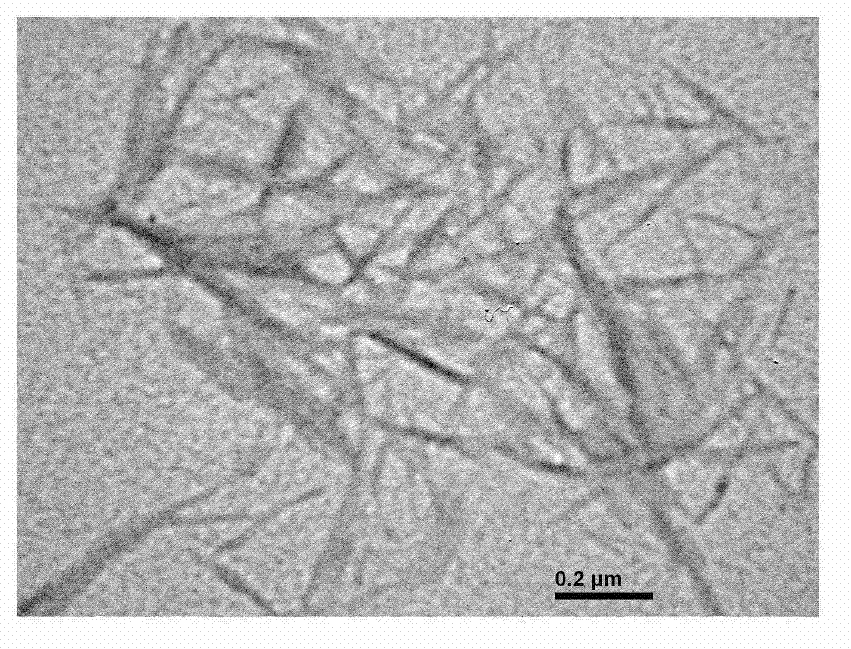Method for preparing nanocellulose whisker by utilizing abandoned mulberry bark
A technology of nanocellulose and mulberry fiber, which is applied to pulping with inorganic alkali, non-woody plant/crop pulp, pulp bleaching, etc., can solve the problems of high price, limited source, insufficient supply of fiber raw materials, etc., and achieve expansion The range of raw materials, the effect of improving economic income
- Summary
- Abstract
- Description
- Claims
- Application Information
AI Technical Summary
Problems solved by technology
Method used
Image
Examples
Embodiment 1
[0021] 1) Remove the surface green bark from the discarded mulberry bark, wash, dry, pulverize with a plant grinder, and filter through an 80-mesh sieve to obtain mulberry bark powder with a particle size less than or equal to 0.2 mm;
[0022] 2) The mulberry powder obtained in step 1) was mixed with 50°C 8wt% ammonia (NH 3 ·H 2 O) solution in the reaction 150min, mulberry powder and ammonia (NH 3 ·H 2 O) the mass ratio of solution is 1:10, repeats 4 times, washes residual alkali with distilled water in the meantime, obtains mulberry fiber;
[0023] 3) using 3wt% trisodium phosphate chloride (Na 3 PO 4 1 / 4NaOCl) under mechanical agitation, the mulberry fiber obtained in 80 ℃ bleaching treatment step 2) 240min, mulberry fiber and chlorinated trisodium phosphate (Na 3 PO 4 The mass ratio of 1 / 4NaOCl) solution is 1:15, repeats 3 times, washes residual chlorine with distilled water in the meantime, obtains high-purity mulberry fiber;
[0024] 4) the high-purity mulberry fib...
Embodiment 2
[0027] 1) Remove the surface green bark from the discarded mulberry bark, wash, dry, pulverize with a plant grinder, and filter through an 80-mesh sieve to obtain mulberry bark powder with a particle size less than or equal to 0.2 mm;
[0028] 2) The mulberry powder obtained in step 1) was mixed with 10wt% ammonia (NH 3 ·H 2 O) in the solution for 120min, the mulberry powder and ammonia (NH 3 ·H 2 O) the mass ratio of solution is 1:15, repeats 4 times, washes residual alkali with distilled water in the meantime, obtains mulberry fiber;
[0029] 3) using 4wt% trisodium phosphate chloride (Na 3 PO 4 1 / 4NaOCl) solution is under mechanical agitation, 90 ℃ of bleaching treatment step 2) the mulberry fiber that obtains in 210min, mulberry fiber and chlorinated trisodium phosphate (Na 3 PO 4 The mass ratio of 1 / 4NaOCl) solution is 1:20, repeats 3 times, washes residual chlorine with distilled water in the meantime, obtains high-purity mulberry fiber;
[0030] 4) the high-purit...
Embodiment 3
[0033] 1) Remove the surface green bark from the discarded mulberry bark, wash, dry, pulverize with a plant grinder, and filter through an 80-mesh sieve to obtain mulberry bark powder with a particle size less than or equal to 0.2 mm;
[0034] 2) The mulberry powder obtained in step 1) was mixed with 10wt% ammonia (NH 3 ·H 2 O) in the solution for 120min, the mulberry powder and ammonia (NH 3 ·H 2 O) the mass ratio of solution is 1:20, repeats 4 times, washes residual alkali with distilled water in the meantime, obtains mulberry fiber;
[0035] 3) Using 5wt% Trisodium Phosphate Chloride (Na 3 PO 4 1 / 4NaOCl) solution is under mechanical agitation, 90 ℃ of bleaching treatment step 2) the mulberry fiber that obtains in 180min, mulberry fiber and chlorinated trisodium phosphate (Na 3 PO 4 The mass ratio of 1 / 4NaOCl) solution is 1:25, repeats 3 times, washes residual chlorine with distilled water in the meantime, obtains high-purity mulberry fiber;
[0036] 4) the high-purit...
PUM
| Property | Measurement | Unit |
|---|---|---|
| particle diameter | aaaaa | aaaaa |
| molecular weight | aaaaa | aaaaa |
Abstract
Description
Claims
Application Information
 Login to View More
Login to View More - R&D
- Intellectual Property
- Life Sciences
- Materials
- Tech Scout
- Unparalleled Data Quality
- Higher Quality Content
- 60% Fewer Hallucinations
Browse by: Latest US Patents, China's latest patents, Technical Efficacy Thesaurus, Application Domain, Technology Topic, Popular Technical Reports.
© 2025 PatSnap. All rights reserved.Legal|Privacy policy|Modern Slavery Act Transparency Statement|Sitemap|About US| Contact US: help@patsnap.com


